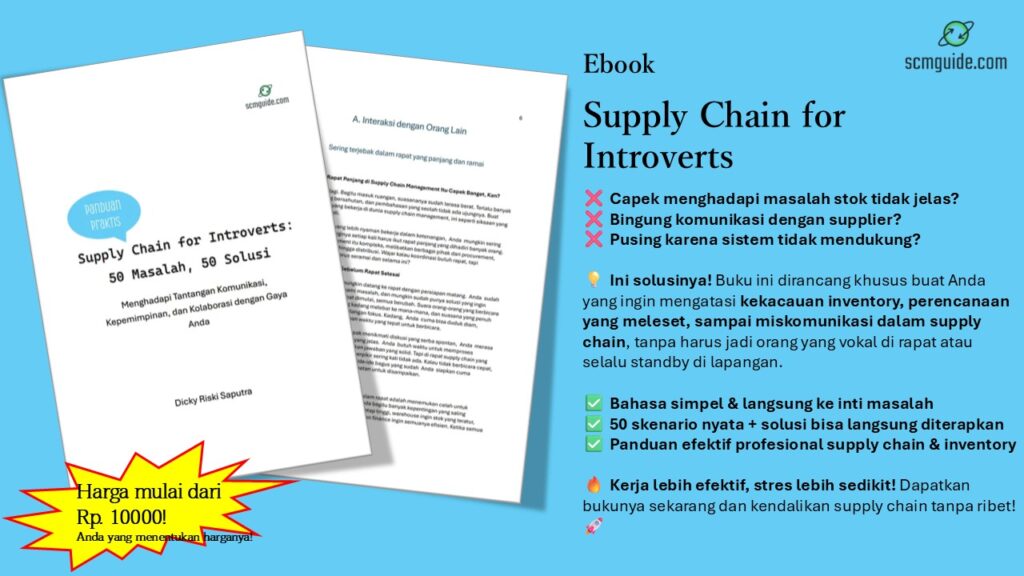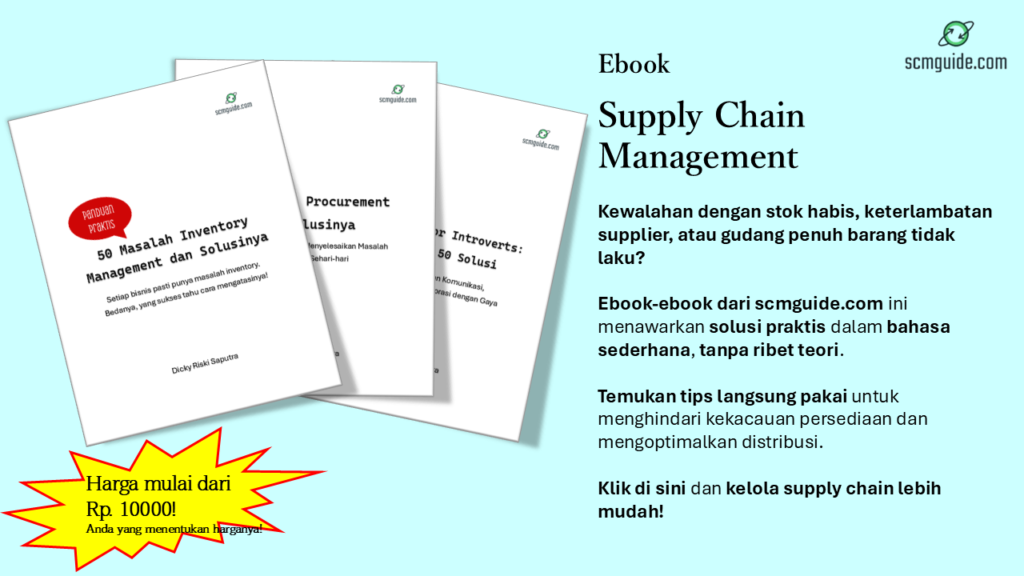You will almost certainly be familiar with the process of receiving raw materials, producing finished goods, and delivering them to customers if you work in a supply chain. All transactions relating to these processes should ideally be completed on the same day.
The question is, do you know which transactions have been completed and which are still in the works?
Have you monitor it? How will it be monitored?
This is the subject of our discussion in this post.
But, before we go any further, make sure you’ve also joined the scmguide telegram channel in order to continue receiving useful articles from this blog.
Table of Contents
What is the definition of daily closing activity?
The purpose of daily closing activity is to monitor the transaction completion status of each process in the supply chain, in this case the processes of receiving, producing, and shipping.
And you must monitor not only transactions between your company and third parties, but also transactions that occur within your organization’s various sections, or shopfloors.
For example, suppose your company is a motorcycle assembly plant with many sections, from machining to painting to assembling the motorcycle itself.
What you need to monitor are not just transactions between your factory and distributors, for example, shipping process. But, shipping and receiving transactions that take place between one section and another, in this case, such as the process of handing over goods between a paint shop and an assembly shop, are also included.
It is your responsibility to ensure that every transaction goes smoothly and that every transaction is completed on the same day.
This is known as daily closing.
What is the importance of the daily closing activity?
Why do you have to do this closing activity every day?
This activity is important for a number of reasons. Let’s take a look.
Improve inventory data accuracy
Because daily closing activity monitors daily transactions, it is, of course, very closely related to the accuracy of the inventory data on a daily basis.

In an ideal world, all data would be updated in real time. However, ensuring that transactions run every second is not a good practice. So, at the very least, you make certain that all transactions are completed on a daily basis, correct?
To consider performance as a basis for future improvements
The daily closing activity will record the results you obtain on a daily basis.
Have all of the plans for receiving goods been carried out?
Are your production results as expected?
Is each delivery made in accordance with the timetable?
By documenting everything, you’ll be able to see how well you’re doing on a daily basis. This is extremely important. Because knowing where you are now will allow you to determine what steps to take next to improve the performance of your operations.
Operations that are disciplined
You are well aware that maintaining high discipline in carrying out every transaction in the supply chain requires a significant amount of effort. Furthermore, disciplining the course of this transaction takes time and special dedication.
Daily closing activities are one method of enforcing discipline across your organization’s various functions in the execution of each supply chain transaction.
This activity will ensure that all transactions run and are completed on the same day. This activity will immediately identify any transaction that does not adhere to procedure.
If something does not go as planned, a quick response is required
The speed with which problems are solved is just as important as the solution itself.
If there are issues with material receipts, production targets that are not met, and deliveries that are not made, whatever solutions you have will be ineffective if you are slow to respond to these issues.
When problems accumulate and become too large, you will require a larger solution to solve them.
The daily closing activity will catch any problems that arise and provide you with enough time to respond quickly.
What are the advantages of daily closing?
The next question is, what advantages do you stand to gain from this daily closing activity?
Here are some of the advantages of implementing this activity.
Accurate stock information
The first advantage is, of course, more accurate stock data.
By ensuring that all transactions are carried out with discipline, the data you hold will be the most up to date, reflecting the actual conditions in the field.
Improved supply chain decision-making
Accurate data is the foundation for making better supply chain decisions.
You will never be able to make an informed decision if you do not use accurate data. In fact, you should probably avoid making any decisions if the data you have cannot be justified in terms of accuracy.
Understand your current performance
Which aspects of your supply chain should be improved?
What activities should you engage in, and what level should you aim for? Can you answer that?
The daily closing activity will tell you:
- How good your supplier’s delivery performance is
- How good your production facility’s performance is
- How good your delivery function performance is
You will be able to determine which areas still require improvement and what you need to do to improve them based on that valuable information.
Transactions in the supply chain will be more disciplined
As I previously stated, establishing discipline in carrying out each transaction takes time and the proper method.
Daily closing is one of the tools that can assist you in achieving that discipline.

Every day, you will be made aware of any transactions that are not carried out in accordance with the procedure. And it is your responsibility to provide feedback, including warnings and sanctions, to any function that is not disciplined in carrying out its daily operations.
Mental discipline will be formed over time if continuous feedback is provided every day.
Quick responses to problems that arise on a daily basis
By carrying out daily closing activities, you are also creating a culture of responding quickly to any problems that arise on a daily basis.
There would be no way for each of those problems to accumulate day after day and become so large that they could be solved by simple solutions.
The key word here is “speed.”
When a problem arises, you will take action as soon as it is small enough to be solved with a simple solution.
And, once again, the daily closing activity enables you to do so.
How to perform daily closing
We’ve arrived at the crucial point. If daily closing activities are so important and beneficial, how do you carry them out?
Here are the steps you must take to put it into action.
It is necessary to understand the plan for receiving, producing, and shipping materials
The first step, of course, is to have, or at least be aware of, a plan for receiving, producing, and shipping materials.
Without a plan, how can you tell if the results you get are on target or not?
Actual VS plan should be updated
The following step is to compare the actual results of receiving, producing, and delivering materials to the plan.
Is everything completed on time, behind the schedule, or even ahead of schedule?
Ideally, of course, the results obtained must be exactly as planned. When it is less than the plan, it indicates that there is a problem, whether it is in the realization process or in the planning process itself.
While results that exceed the plan can be a problem as well. This could imply that you have more capacity than you require. You should look into it.
Determine the achievement ratio (actual VS plan)
Calculate what percentage of the achievement ratio to the plan has been set after you have obtained your daily achievement figures.
Is it exactly 100%? Less than a hundred percent? Or, more than a hundred percent?
What is your expected level of success? Are there any allowances available?
Visualize using graphics
Tables and numbers are not as visually appealing as graphs. Thus, create a graphical report for your daily closing report.
A bar graph can be used to compare plans and realizations, and a line graph on the second axis can be used to show your achievements as a percentage.
It would be preferable if you also left a comment whenever your results fell short of your expectations.
Distribute information to related functions
Distribute this daily closing information to all relevant functions. Make sure that all functions are aware of their performance on a daily basis.
Information that you keep to yourself is useless until it is shared with the function that should be aware of it.
Determine the root cause and a solution
If a goal is not met, determine the root cause and the solution as soon as possible.
This is something you should do as soon as you notice a problem so it doesn’t linger and worsen.
Involve related functions as well to jointly analyze the situation and find solutions.
Directly visit the field
The data and information you receive must be verified on the spot. See for yourself what’s going on. Sometimes the data does not accurately reflect the field conditions. That is why you should still look it over in person.
Quick response
As I have repeatedly stated, any problems that arise must be addressed as soon as possible. Don’t let it linger and grow, let alone forget about it.
Make it a habit for all functions to respond at the same speed. This daily closing activity could be one of the training tools used to accomplish this.
Keep track of the outcomes of the solutions you implement
Don’t let go after you’ve identified and implemented a solution. Keep track of how well the solution is performing. Make it the new standard.
Conclusion
The daily closing activity is a critical daily activity for you to implement.
By carrying out this activity, you will have more accurate data, better decision-making, and more disciplined people.
With daily closing activities, you are not allowing problems to occur for an extended period of time. When problems are minor, you deal with them. You solve it with lightning speed.
So, have you begun this activity?
I hope it useful!
If you found this article useful, please share it with your friends and join the scmguide telegram channel where I discuss many more supply chain management topics. Feel free to use any of the articles on this blog for whatever purpose you want, including commercial ones, without attribution.

 by
by 



